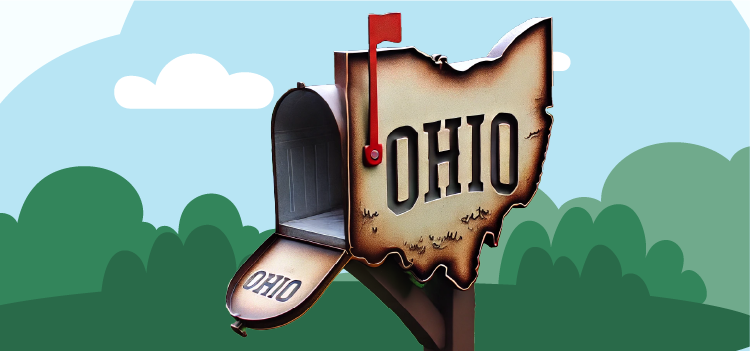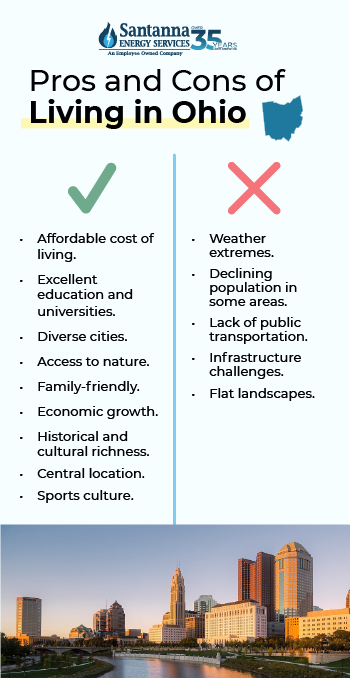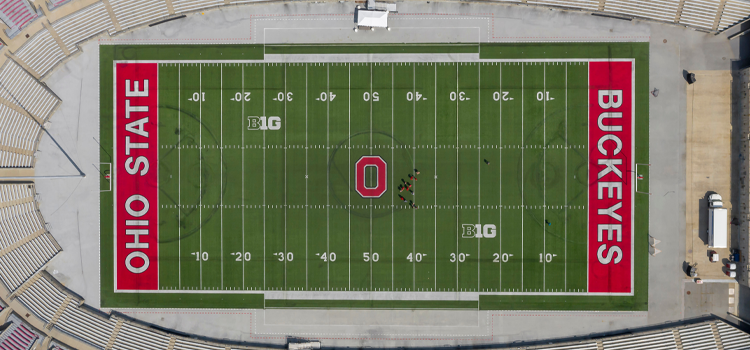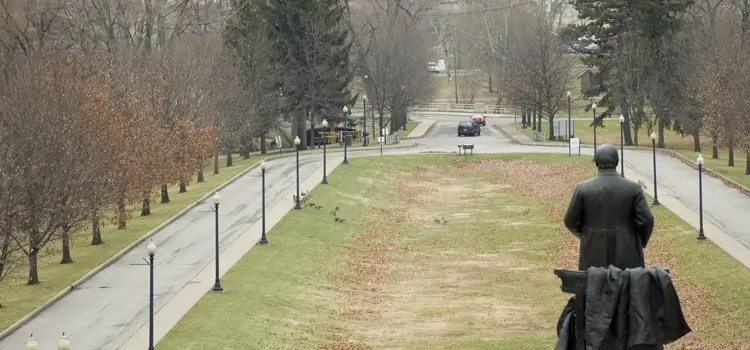Is Ohio a Good Place to Live? Pros and Cons of Living in Ohio
by Jenna Mendez
11.6 min read

Living in Ohio offers a balanced mix of urban energy, outdoor beauty, and affordable living. With major cities like Columbus, Cleveland, and Cincinnati offering a thriving cultural and economic scene, Ohio is a hub for professionals, students, and families alike. Ohio offers a great blend of affordability, opportunities, and culture that some states just can’t compete with!
Pros and cons of living in Ohio

Like any other state, there are pros and cons to living in Ohio. Here are some of Ohio’s most common pros and cons:
Pros of living in Ohio
Affordable cost of living
Ohio consistently ranks as one of the most affordable states in the U.S. for both rent and homeownership. Utilities, groceries, and healthcare are also relatively inexpensive.
Ohio ranked as the fifth-best state to quickly save for a home deposit, with a median household income of $65,720 and an average home value of $222,715, which is 46.5% lower than the median home price in the U.S. Cities like Cleveland, Youngstown, and Niles offer some of the most affordable housing markets in the country.
Education & universities
Ohio has a strong higher education system, anchored by Ohio State University, which is known for both academic programs and sports. Case Western Reserve University, located in Cleveland, is a prestigious private research university known for its medical and engineering programs.
Ohio’s education system includes a variety of public, private, and charter schools, with some districts offering top-tier education. Suburban areas around cities like Columbus and Cleveland are particularly known for high-quality schools.
Diverse cities
Many of Ohio’s major cities offer a vibrant arts scene with galleries, theaters, and music venues. Cleveland is home to the Rock and Roll Hall of Fame, and Cincinnati is known for its historic architecture and thriving arts district. Ohio cities are becoming more diverse, with communities representing a wide variety of cultures.
Access to nature
Ohio has over 70 state parks, offering hiking, fishing, camping, and boating. Hocking Hills is a particularly popular destination for nature lovers. The northern part of Ohio gives residents access to Lake Erie, providing beaches, water sports, and boating opportunities.

Family-Friendly
Many Ohio suburbs have lower crime rates compared to large cities across the U.S. This makes the state an attractive option for families seeking safety. Ohio’s violent crime level is 23% lower than the national average.
Ohio is filled with zoos, museums, theme parks, and children’s play centers throughout the state. With lots to do in major cities and local towns, there’s no shortage of weekend activities.
Job opportunities and economic growth
Ohio’s economy is historically rooted in manufacturing, and it remains strong in this sector. Some of Ohio’s top job markets include:
- Home Health and Personal Care Aides
- Laborers and Freight, Stock, and Material Handlers
- Registered Nurses
- Software Developers
- Tractor Trailer Drivers
- Nurse Practitioners
- Industrial Machinery Mechanics
This economic diversification helps to stabilize the state’s economy and attract a variety of skilled workers from different fields.
What is Ohio’s minimum wage?
Ohio’s minimum wage sits at $10.45 in 2024. The national minimum wage stands at $7.25 per hour.
Ohio’s 2024 minimum wage increased $0.35 from 2023’s minimum wage rate.
The minimum wage applies to employees of businesses with annual gross receipts of more than $385,000 per year. For tipped employees, the minimum wage in Ohio is $5.25 per hour, with the expectation that total earnings (including tips) meet or exceed the standard minimum wage.
Growing food & beverage scene
Cities like Cleveland, Cincinnati, and Columbus have all become hotspots for craft beer, with many local breweries gaining national attention. Ohio’s rich farmland supports a growing farm-to-table dining culture, where restaurants focus on using fresh, locally sourced ingredients.
The best restaurants in Ohio
- The Thurman Café (Columbus): This spot is known for its massive burgers, especially the Thurmanator, a towering burger with two 12oz patties, bacon, cheddar, mozzarella, sautéed mushrooms, and onions.
- Pier W (Cleveland): Pier W offers upscale seafood with a stunning view of Lake Erie. Their menu features fresh fish, lobster, and oysters.
- Slyman’s Deli (Cleveland): Slyman’s is known for its enormous corned beef sandwiches piled high with tender meat. This old-school deli is a must-visit for anyone craving a traditional deli experience with generous portions.
- Eli Knows His BBQ (Cincinnati): This local favorite is beloved by all with locally sourced meats and iconic cornbread.
Historical and cultural richness
From Native American mounds to its role in the Underground Railroad, Ohio is full of historical sites and museums that celebrate its past. Here are some of the most iconic and “must-see” museums in Ohio:
- National Museum of the US Air Force (Riverside)
- Center of Science and Industry (COSI) (Columbus)
- Pro Football Hall of Fame (Canton)
- The Cleveland Museum of Art
- House from A Christmas Story (Cleveland)
- Merry-Go-Round Museum (Sandusky)
Ohio is also known for hosting diverse cultural festivals throughout the year, including German, Greek, Italian, and Hispanic celebrations, particularly in urban centers.
Central location & accessibility
Ohio’s central location within the Midwest makes it easy to travel to neighboring states or major cities like Chicago, New York, and Washington, D.C. Ohio’s cities are well-connected with airports, highways, and even Amtrak services, making it easy to get around both within and outside the state.
Sports culture & teams
Ohio’s residents are some of the most passionate sports fans in the country. The Cleveland Browns and Cincinnati Bengals of the NFL inspire strong loyalties. The Ohio State Buckeyes’ college football team has one of the largest and most dedicated fanbases in the nation, known for their tailgates and game-day energy.
In addition to football, Ohio has major league representation in baseball with the Cleveland Guardians and Cincinnati Reds, as well as the NBA’s Cleveland Cavaliers. Sports are not just a pastime; they are a part of the state’s identity.

Cons of Living in Ohio
Weather extremes
Ohio’s winters can be brutal, especially in northern parts of the state where snowfall is heavy. Cold temperatures and icy roads can make commuting dangerous. Columbus comes in with an average high of 34 degrees in the winter.
Summers in Ohio are often marked by high temperatures and humidity, making outdoor activities less enjoyable. With temperatures continuing to rise year over year, Ohio has seen many days well over 90 degrees.

Declining population in some areas
Ohio is prone to rust belt cities. Cities like Youngstown and Akron have experienced population declines as industries left, leading to a loss of economic opportunities.
While major cities like Columbus are growing, smaller towns and rural areas are seeing young people and families move to other states in search of better jobs and more vibrant communities.
Lack of public transportation
Ohio’s rural areas and smaller towns have very few public transportation options. This lack of infrastructure can make it difficult for residents to commute without a personal vehicle. In some smaller cities, public transport systems are underfunded and unreliable, with long wait times and limited routes.
Infrastructure challenges
Ohio’s infrastructure, particularly in rural areas and older industrial cities, is in need of repair. Potholes, crumbling bridges, and outdated public utilities can be a nuisance.
Flat landscapes
Ohio’s landscape is largely flat, with rolling plains and agricultural land dominating much of the state. While the flat terrain makes for easy driving and biking, it can be less appealing for those who crave dramatic natural vistas.
Living in Ohio’s Major Cities
Considering a move to these major cities? Here’s what to know:
Is Cleveland Ohio a good place to live?
Cleveland Ohio is generally affordable, with housing costs compared to national averages. Cleveland has a few top-notch thriving industries such as healthcare, manufacturing, and education. Home to the Rock and Roll Hall of Fame, Playhouse Square, and Cleveland Museum of Art, this major Ohio city has a lot to offer.
Best restaurants in Cleveland Ohio: Lola Bistro (fine dining, modern American), Mabel’s BBQ (Michael Symon’s famous BBQ), Blue Point Grille (seafood), Sokolowski’s University Inn (classic Polish comfort food).
Is Columbus Ohio a good place to live?
Columbus has a rapidly growing tech scene, opportunities for state government jobs, and a strong job market. Columbus is home to The Ohio State University, contributing to a vibrant college town atmosphere. Columbus has a blend of urban and suburban living, lots of parks, and recreational areas.
Best restaurants in Columbus OH: The Refectory Restaurant & Wine Shop (French-inspired fine dining), Northstar Café (farm-to-table, casual), Hot Chicken Takeover (Nashville-style fried chicken), Lindey’s (classic bistro with upscale American fare).
Is Cincinnati Ohio a good place to live?
Cincinnati is generally affordable, with housing prices lower than the national average, making it accessible for families and young professionals. Cincinnati has abundant parks and recreational areas, including Eden Park and the Cincinnati Zoo & Botanical Garden, as well as access to the Ohio River for water activities and biking trails.
Best restaurants in Cincinnati OH: Nati Nati (local favorite), Sotto (Italian), The Precinct (steakhouse), and Cincinnati’s iconic Skyline Chili.
What’s the Weather Like in Ohio?
Winter (December – February)
Winters in Ohio are cold and snowy, with temperatures ranging between 20°F and 40°F, depending on the region. Northern Ohio, especially near Lake Erie, is prone to lake-effect snow, while southern Ohio experiences milder winters.
Spring (March – May)
Spring in Ohio brings gradual warming, with temperatures ranging from 40°F to 70°F. However, it is also a season known for unpredictable weather, including rain, thunderstorms, and the occasional tornado.
Flooding can occur in areas near rivers and lakes due to heavy spring rains. Tornado activity is possible, particularly in the southern part of the state.
Summer (June – August)
Ohio summers are hot and humid, with temperatures reaching between 75°F and 90°F. The southern part of the state can feel particularly muggy due to higher humidity levels. Occasional thunderstorms and heatwaves can occur during the summer months. Northern Ohio often benefits from cool breezes off Lake Erie.
Fall (September – November)
Fall in Ohio is marked by cooler temperatures, ranging from 50°F to 70°F, and beautiful foliage. However, fall can also bring occasional chilly rain showers.
Severe weather
Thunderstorms are common throughout the state, with the possibility of hail, strong winds, and heavy rain leading to flash flooding. Lightning strikes and heavy winds can damage property and knock out power. Ohio experiences severe thunderstorms most frequently in late spring and early summer.
Are there tornadoes in Ohio?
Ohio, particularly in the spring and summer months, faces a moderate risk of tornadoes and severe storms. While tornadoes are not as common as in states like Kansas or Oklahoma, Ohio still experiences them.
2024 alone was an unprecedented season for tornado activity in Ohio. The state saw 66 tornadoes, beating out the previous record of 62 that was set in 1992. Tornadoes in Ohio are most active from April to July.
If you’re looking to move to Ohio, consider purchasing a home with a crawlspace or basement away from windows for protection. Keep a tornado emergency kit with items like water, non-perishable food, a flashlight, batteries, and a weather radio.
Average cost of living in Ohio
Ohio consistently ranks as one of the most affordable states in the U.S. The overall cost of living is much lower than in coastal states. According to Jobs Ohio, “the cost of living in Ohio is lower than both the US and Midwest average.”
The average cost of living in Ohio comes in at around $71,179 for a family of four.
Energy costs are also lower than average, at 15.92 cents/kWh thanks to access to local resources and a relatively mild climate. The average cents/kWh in the U.S. comes out to 16.62.
To provide more context about Ohio’s cost of living, let’s explore how expenses and average salaries compare across major cities in the state. Here’s a breakdown of the average salary, housing cost, and expenses:
Fast Facts About Costs in Major Cities in Ohio
| City | Average Salary | Median Home Price | Rent (1-Bedroom Apartment) | Cost of Living (Monthly) |
|---|---|---|---|---|
| Columbus | $84,582 | $323,400 | $1,000 – $1,300 | $2,202 |
| Cleveland | $87,513 | $237,600 | $800 – $1,100 | $1,865 |
| Cincinnati | $94,421 | $293,300 | $900 – $1,200 | $1,750 |
| Toledo | $87,169 | $186,300 | $700 – $900 | $1,704 |
| Dayton | $86,084 | $254,900 | $750 – $1,000 | $1,721 |
Overall, is Ohio a good place to live?
Yes, Ohio is a great place to live! Ohio offers a balance of affordability, job opportunities, and a good quality of life. It's ideal for families, young professionals, and retirees alike. The diversity of cities, combined with access to nature and outdoor activities, makes it appealing to many lifestyles.
Want to make the move to Ohio? Don't forget your utilities!
Have we convinced you Ohio is the right place for you? Don't forget to find the perfect utility provider so you don't walk into your new Ohio home without gas or electricity. Santanna Energy Services serves Ohio residents with natural gas and electricity plans. Our expert staff can help you navigate this process with ease.
Ohio is a hidden gem for those who value affordability, diverse job prospects, and a family-friendly environment. While it's true that winters can be cold and certain areas still face economic challenges, the overall benefits—like low living costs, access to nature, and vibrant city life—make Ohio worth considering. It's a state where you can build a career, raise a family, or enjoy a peaceful retirement. Just remember to pack that winter coat!
We love our Ohio customers! Santanna Energy Services has been proudly providing easy home electricity and gas plans to our Ohio customers for over 35 years. We're proud to offer a wide range of renewable energy solutions and products tailored to meet the unique needs of our Buckeyes. Our mission is to provide innovative and cost-effective energy solutions that will help our customers achieve their energy goals and help the environment along the way.
Jenna Mendez is a Midwest native with lifelong roots in Illinois and time spent in Ohio during college, giving her a deep understanding of the Midwest region’s people, climate, and energy needs. She brings firsthand experience and local insight to topics that matter to Midwest homeowners, especially energy efficiency, sustainability, and home living. Jenna specializes in writing about eco-friendly living, all things Midwest, renewable energy, and practical ways to reduce energy costs. Jenna brings a trusted, and local hometown voice to every article she writes, helping readers live well, and sustainably, right where they are.







